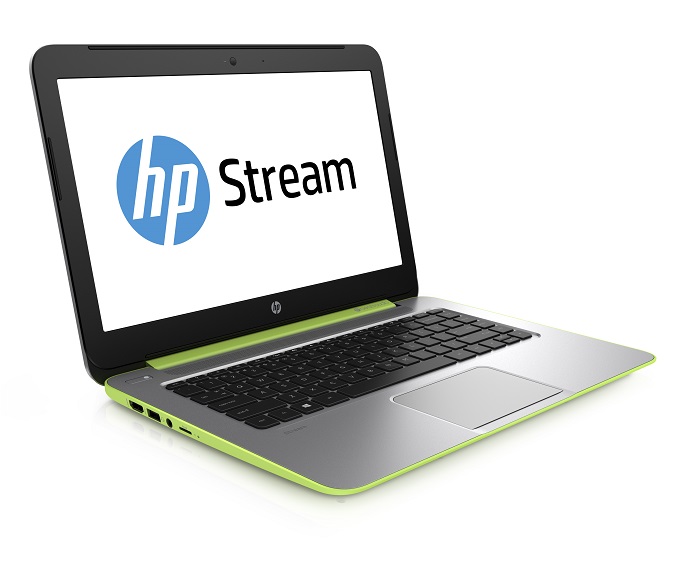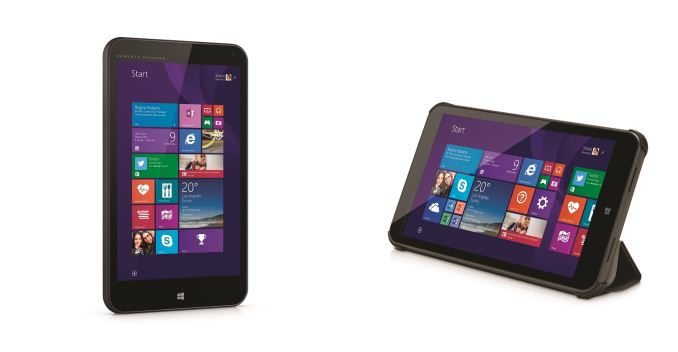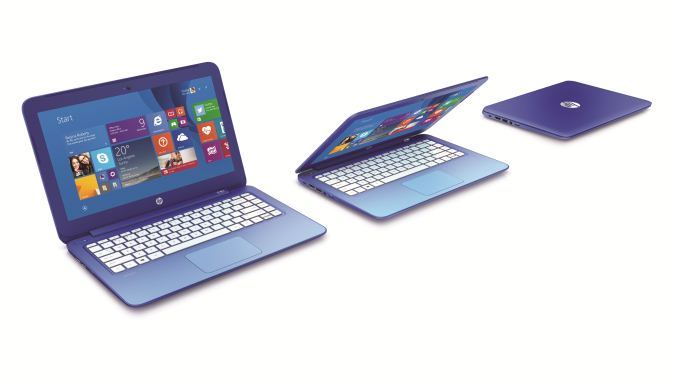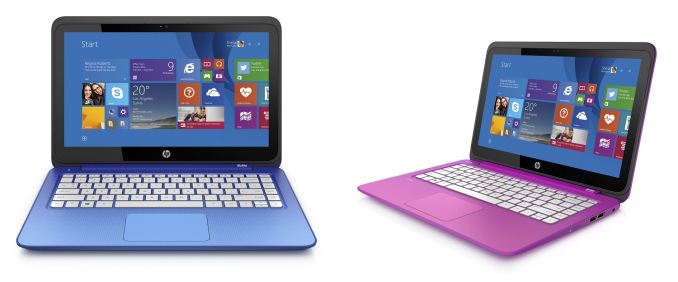HP Announces Low Cost Stream Laptops And Tablets
by Brett Howse on September 29, 2014 11:30 PM EST
Several weeks ago, Hewlet-Packard announced the HP Stream 14” Notebook. The Stream series is HP’s version of the low cost Windows laptop, meant to compete head to head with Chromebooks on price, but still offer the power of a fully fleshed out operating system. The Stream 14 (pictured above) is available to purchase now for only $299, and comes with an AMD A4 APU, 2 GB of RAM, and 32 GB of eMMC storage.
Today, HP revealed the rest of the Stream lineup, with two additional laptops, and two tablets. In a world where the Chromebook has put some serious price pressure on the Average Selling Price of low cost computing, OEMs are trying to win over consumers with nice designs and additional perks in an effort to differentiate from the competition.
First up is the laptops. There are two screen sizes with the smaller being 11.6” and the mid-size being 13.3”, to compliment the already released 14” model. Exact specifications have not been disclosed yet, but both units will be powered by an Intel dual-core Celeron processor based on the Bay Trail architecture. This will make it a fanless device, and both come with 2 GB of RAM and 32 GB of eMMC storage. The 13.3” device has an optional touchscreen to go with the 1366x768 resolution that both laptops share. The 13.3” model also is available with optional 4G connectivity, and as a value add, HP is including 200 MB of free data every month for the life of the device. As another value add, HP is offering one year of Office 365 personal, which includes 1 TB of online storage and 60 Skype minutes per month. Battery life is listed from HP at 8:15 for the 11.6” model, and 7:45 for the 13.3” model. The HP Stream laptops are available in several colors, and will be priced at $199.99 for the 11.6” model and $229.99 as the starting price for the 13.3” model.
With the race to the bottom on pricing, one has to wonder where it will end, but all we know is it has not ended yet. Today HP also announced the HP Stream 7 Tablet, which is a 7” Windows 8.1 with Bing device that comes in at only $99.99. If you are in need of a slightly larger device, with optional 4G, then HP also has you covered with the HP Stream 8 which has a starting price of $149.99. Both tablets are powered by Intel Atom quad-core processors, and 1366x768 screens. Like the larger of the two laptops, the 8” tablet, if equipped with the optional 4G, comes with 200 MB of data per month for the life of the device, and both also come with Office 365 personal for one year. Office 365 personal is $70 to purchase on its own, so for only $30 more you can get it with a 7” tablet.
 HP Stream 7 (left) HP Stream 8 (right)
HP Stream 7 (left) HP Stream 8 (right)
It has been a bit painful to see the thin and light Chromebooks popping up over the last couple of years, and it was always especially frustrating that low cost Windows laptops were large, thick, noisy, and had very slow spinning hard disks. It is great to see the Chromebook styling now coming to Windows PCs, and with the Chromebook pricing as well. Microsoft is making a big push to recapture some of this end of the market by offering Windows 8.1 with Bing, and they are now starting to see some examples of great looking Chromebook competitors.
The tablet side is not as rosy, with Windows 8.1 not having the same mobile ecosystem as Android, but at least the pricing is now in line for the bottom end of the market. The add-ons offered by HP are pretty strong, with the Office 365 Personal costing almost as much as the tablet itself, and 4G for life is a nice bonus to those who just need a bit of data when they are not on Wi-Fi. Of course what the Windows Tablets need as the killer app is the touch version of Office, but that is not available as of yet, so anyone who wants to take advantage of Office 365 will have to do it from a 7-8” desktop, but as with most Windows tablets these can be connected to a keyboard, mouse, and monitor if you were so inclined. This is a strong push by HP to get a foothold in the low end of the market, with sharp looking products and useful value adds as well. Hopefully we can get some of these as review units to give you the full break down on just what you get for so little money.
Source: HP












49 Comments
View All Comments
Stephen Barrett - Tuesday, September 30, 2014 - link
the A4 mentioned in this article is an AMD A4 CPU not an ARM CPUEast17 - Tuesday, September 30, 2014 - link
Since AMD launched Jaguar processors, I would never touch any Bay Trail powered device. The only way Intel's low power products have invaded the market is by Intel using dumping prices and also strong-arming manufacturers using the old tactic "If you build AMD systems, your discounts for our Intel CPUs won't be so great anymore and no matter how, we own 85% of the market. You don't want to mess with the discounts for the processors powering 85% the products you manufacture." I've seen this first hand at HP as I've been in this industry for the past 18 years. With AMD's Jaguar or the new Puma chips you get more x86 performance and a lot more 3D performance. Sure Bay Trail gets better battery autonomy, but if more battery life is what you desperately need, you can get an extra Li-Poly battery pack that will get you around 40 hours of continuous power for about 0,9 Kg of weight. Therefore you HAVE an option, but with Bay Trail there is NO option to have more x86 nor 3D performance while the extra 1 or 2 hours of battery life is not enough if you will be working more than a day away from a power outlet. Bay Trail obviously offers no advantage over AMD's products, except for the great price that Intel's sells it at. Just look at the billions lost each trimester by Intel's low power division. How can you lose billions each quarter if you're selling millions of processors and you have literally hundreds of design wins?! Simple, you're using dumping. Sites like Anand's (that I've been reading since way back in 1999) will never touch on this subject as this will get you uninvited from EVERY Intel related events. No more products to review, no more insights, no more "relaxed" NDAs etc. and I don't blame Anand for anything as this is also a business.dabotsonline - Tuesday, September 30, 2014 - link
Interesting points!Minion4Hire - Tuesday, September 30, 2014 - link
In the current age of ultra-light electronics, grams matter, let alone a full kilogram. Consumers don't want to have to carry around 5 pound laptops with 2 pound batteries and 2 pound AC adapters. They want the sleek lightweight package that started with Apple's Macbook Air and culminated in the Ultrabook.Ultrabooks are very TDP limited. They have small (often not removable) batteries and small heatsinks. At a given level of performance, AMD's processors tend to consume more power and produce more heat than Intel's offerings. That means that someone looking for an AMD laptop with the same battery life and thermal characteristics as an Intel machine will end up with something that performs worse. Maybe that user will also end up spending less money, but Ultrabooks started off as a premium product, one that offered a similarly premium level of performance.
But these Chromebook-level devices are a different story. You can see that HP is using an AMD A4 (granted, a tablet-level variant) in the Stream 14. So I'm not entirely sure what you're complaining about.
Wolfpup - Tuesday, September 30, 2014 - link
AMD's Atom competitor is used quite a lot in low end notebooks, but the question is...why isn't it used in tablets? I think I've read of one or two that do, but never actually seen one in a shipping device.Hmm, looks like Puma basically uses less power at the same die process than Jaguar...looks like the sort of tweaks to idle power that Haswell brought, almost that type of deal. It sure seems like it would work for tablets...
IntelUser2000 - Tuesday, September 30, 2014 - link
"http://images.anandtech.com/doci/7974/Screen-Shot-...Based on the data given by AMD, its nowhere enough. It's on par with Haswell's level of system power, and while that's low for Core, its way higher than Atom. On Haswell, 30WHr battery will give you 5-6 hours of battery life. With Atoms, you can get an 8-inch device going down to 15WHr battery achieving 8 hour battery life.
That's not just process alone, since 32nm Atoms did quite well in terms of battery.
Wolfpup - Tuesday, September 30, 2014 - link
I'll confess I don't know much about Puma...probably because Anandtech hasn't covered it that I can recall!Jaguar (their second gen Atom competitor) launched earlier than second gen Atom, and offers basically Athlon 64 performance at a given clock speed. The CPU performance is a bit worse than second gen Atom (though still good as I recall), but the GPU performance is a bit better.
I'm not sure about power though since AMD's stuck on 28nm while second gen Atom is on 22.
Still, even with Bobcat I remember thinking "why isn't this in a tablet?" Even more so now...I don't think AMD's gotten hardly any tablet wins, and I don't know why. Maybe it just doesn't measure up because of the 28nm process?
Or maybe it's entirely due to the same reasons Athlon 64 was so heavily ignored 10 years ago even when it was clear cut the better CPU design. At any rate, it sure seems like there should be a heck of a lot more AMD based tablets right now. They'd be better for games than Atom, I'd think, and have at worst just slightly worse CPU performance.
victorson - Tuesday, September 30, 2014 - link
Wow, those are really awesome devices and having Bay Trail on board is nice. Great pick for people who don't need the most of performance, yet still need some apps (Chromebook's lack of Skype for instance is a deal-breaker).yannigr2 - Tuesday, September 30, 2014 - link
The AMD model was first rumored to be $199. $299 now? And all the cheaper ones are Intel Bay Trail? Right.... Intel cheaper than AMD? Thank God Intel stopped it's monopolistic tactics. Right? Right....PS The AMD is also fanless.
tipoo - Tuesday, September 30, 2014 - link
Also a smaller screen size, though I doubt that makes the $100